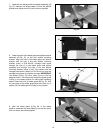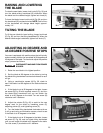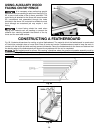
22
5. Depending on the type of saw blade being used, the
cursor (D) Fig. 64, may need adjustment to compensate
for the blade thickness.To adjust the cursor, make a test
cut on a piece of lumber and measure the finished cut,
or you can place the rip fence against the blade as
shown earlier in the manual. If a minor adjustment is
necessary, loosen two screws (E) Fig. 64, and move the
cursor (D) as necessary.
Fig. 64
D
E
E
MITER GAGE OPERATION
AND ADJUSTMENT
Insert the miter gage bar (B) Fig. 65, into the miter gage
slot. Insert the metal stud on the bottom of the miter
gage body (C) Fig. 65, into the non tapped hole in the
miter gage bar. Place a 21/64" flat washer (D) Fig. 65,
onto the miter gage handle (A). Insert the threaded end
of the miter gage handle (A) Fig. 65 through the slot (E)
on the miter gage body and thread the handle into the
miter gage bar (B).
The miter gage is equipped with adjustable index stops
at 90 degrees and 45 degrees right and left. The index
stops can be adjusted by tightening or loosening the
three adjusting screws (B) Fig. 66.
To rotate the miter gage, loosen lock knob (A) Fig. 66,
and move the body of the miter gage (C) to the desired
angle.
The miter gage body will stop at 90 degrees and 45
degrees both right and left. To rotate the miter gage
body past these points, lift the stop link (D) Fig. 66, up
and out of the way.
The miter gage is equipped with a special washer (E)
Fig. 67, and flat head screw (F), which are to be
assembled to the end of the miter gage bar.
The head of the miter gage pivots on a special tapered
screw (G) that fastens the head to the miter gage bar.
If the miter gage head does not pivot freely, or pivots
too freely, it can be adjusted by loosening set screw (H)
Fig. 67, and turning the screw (G), in or out. Be certain
to tighten screw (H) after adjustment is made.
Fig. 65
Fig. 66
Fig. 67
A
C
A
B
B
B
D
E
C
D


















